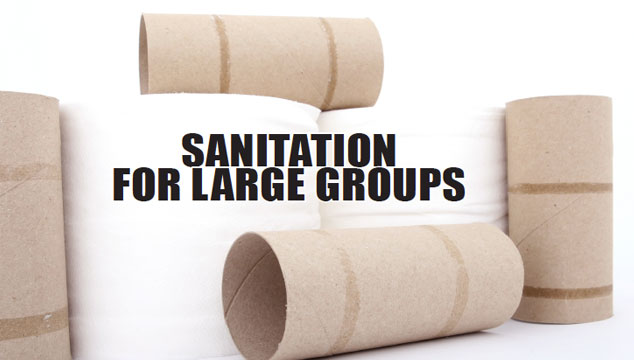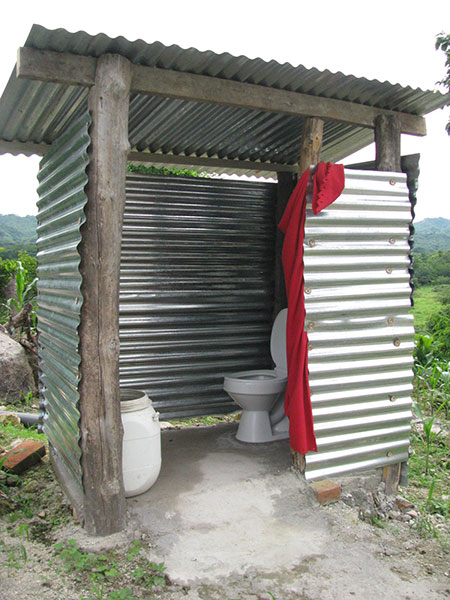
If you have put sanitation preparations on the back burner, diseases like cholera are a great reason to rethink your priorities. Strains of cholera present in the Haiti quake killed in as little as two hours after infection because of dehydration. Patients produced 3 to 5 gallons of rice water like diarrhea per day and vomited clear liquid. Cholera beds are easily disinfected cots lined with 55-gallon drum liners with a hole cut out in the center underneath the patient’s backside. Left untreated cholera boasts a mortality rate of 50-60%. Cholera outbreaks between 1817 and 1917 killed 38 million people even with functioning sanitation such as it was at that time.
In the absence of infrastructure, sanitation and hygiene problems quickly arise. Once surface water becomes contaminated by human waste, diseases like cholera will return with a vengeance. Ironically, the US may be hard hit by many sanitation related diseases. Few people know how to treat and prevent these diseases in the US anymore. Most of us only read about them in medical texts, we don’t typically stockpile medicines to treat diseases that won’t be encountered. Education and distribution of national stockpiles will unprepared for this type of emergency.
Management of Human Waste
Creating a mid-term to long-term sanitation and hygiene solution for a large group at a fixed site is a large undertaking. Temporary facilities for a smaller or more nomadic group could be as simple as a bucket or rocket box with a lid or a chemical toilet. Although these temporary solutions are half measures.
Under normal conditions, proper sewage or septic systems should be installed and maintained to code. Improvised septic systems before things go south could break laws or codes, incur penalties, fines, costly cleanup, result in property being condemned, or create obstacles to obtaining permits for future improvements such as drilling a well. Drastic times may call for drastic measures. If infrastructure is failing than losing family members to illness is a far more pressing problem than a possible fine one day. Government may not function on any level for who knows how long, and code violations will not likely be first order of business once it’s back up and running.
- Groundwater – Dig test shafts if water table depth is unknown. Pit latrines shouldn’t be used in areas with shallow ground water.
- Surface Water – Pit latrines should be located far from surface water, covered against precipitation, and located out of the path of runoff.
- Don’t Locate Pipes or Tanks Too Close to Trees – Roots will grow into lines and cause problems.
- Separate Waste by Type – Only excrement and toilet paper should go into septic systems. Urine should be deposited in urinals. Kitchen waste, garbage that can and cannot be burned, compost, and recyclables should all be dealt with separately. This extends time between pump outs and prevents the spread of disease.
- Closing Latrines – Fill with earth. Top trenches with clean earth and compact to a foot above ground level.
- Hand Washing Station – All toilets, latrines, and urinals should include hand washing stations nearby.
Urine Diverting Dry Toilets
Separating urine and fecal matter helps prevent the spread of diseases, including cholera. Urine diverting dry toilets are an option for survival use but building them can be complicated.
Composting Toilets

Composting toilets are popular on islands and other places that lack sewage systems where groundwater contamination is difficult to avoid. They’re dry toilets that treat solid human waste by composting or aerobic decomposition. Commercial versions aren’t cheap, but you can build them yourself with basic carpentry skills.
Composting toilets are low volume and fans help them to process waste faster. Sawdust, peat moss, and other carbon products are added to treat. The end product resembles dark, loamy soil and can often be used in the garden.
Outdoor Latrines
Outdoor latrines are simple and inexpensive to construct which makes them widely used in developing nations, militaries, and with survivalists.
Deep Pit Latrine – Since the military uses folding two-seat boxes, you might be able to find them in a military surplus store. You can also just build your own. In this latrine, long boxes with lidded seats straddle a 2’ wide x 6’ deep trench. Saw dust or biodegradable kitty litter can be used to keep the smell down and the lids help with that too.
Pail Latrine – Pail latrines are necessary when surface or groundwater make digging not an option. They are constructed as above, but use pails or buckets instead of a pit. Generally, they feature a hanging door so pails can be removed and emptied. Pails must be emptied and cleaned daily.
Chamber Pots
Chamber pots are handy for use in vehicles, tents, and homes that lack indoor plumbing. They have been in us for millennia. It may sound uncivilized but I assure you they are the better option over climbing out of your sleeping bag on cold, winter nights. Even more so if you have to leave the comfort of your abode. Chamber pots should obviously be covered and cleaned out every morning.
Outhouses
This oldy will surely be pressed back into use. Outhouses are typically vented wooden shacks that can be picked up and moved.

This enables them to be pumped out or relocated when the pit fills up.
Urinals
Separate urinals should be installed in latrines to minimize the spread of infectious disease and speed composting of human waste.
Pipe Urinal – A pipe urinal is constructed by setting pipes and screened ventilation shafts in a seepage pit full of crushed stone, small stones, or large gravel. Funnels are placed in the pipes.
Trough Urinal – A trough is constructed just below waist height which empties into a seepage pit or dispersal field.
Improvised Trailer Hookups
It will be necessary to double or even quintuple the amount of families on the same property to provide security, produce food, and share resources. For many survivalists, trailers provide a flexible mobile solution to many of the storage and privacy issues that arise. Due to unforeseen circumstances and limited resources, preppers cannot always park trailers on a slab complete with water, power, and sewer or septic hookups. Downed or unmaintained infrastructure, backed up sewers, or full septic tanks make improvised septic systems a common need.
55 Gallon Drum Septic System – A solution I have used is to bury a couple of perforated 55-gallon poly drums side by side. Bury them in a dispersal pit filled first with rocks and then either smaller rock or crushed rock about ¾” size.

The system will eventually fill up as home septic tanks are 10-20 times this capacity. Although many chores that use water will happen elsewhere which reduces usage. Water use is also greatly reduced under survival conditions. Nonetheless, changes must be made to water usage habits or the tanks will fill to capacity. Capacity can be can be added along a trench provided the trailer can be moved down the line. You will want to install all the drums at the same time though as you need to avoid digging in the dispersal field.
55 Gallon Drum Septic System with Dispersal Field – For a longer duration survival ordeal, use a variation of this system with a larger dispersal field and drums which are not perforated. This can last a family a couple of years between cleanouts.
For this solution, dig a trench approximately 4’ wide x 26’ long x 3’ deep. Run perforated pipes through the dispersion field pipes on a ¼ downward slope. Drums can be stair stepped and connected to create a two chambered septic system as demonstrated in the diagram.
Wipes & Wiping
We’re going to get a little personal here but this is a necessary consideration when planning for survival.
Toilet Paper
Most Americans use toilet paper. Storing toilet paper takes up a lot of space. Plus you’ll need a backup system when it runs out.
Biodegradable, Flushable Wipes
These are hard on plumbing systems and should be disposed of separately. They can be dried, composted separately, and returned to the earth. Wet wipes are much more sanitary than dry wipes. If they dry out in storage, they can be rehydrated with water and a little glycerin.
The solution can be modified with 50% witch hazel if the user suffers from hemorrhoids. As an aside, preppers should keep plenty of witch hazel on hand in any case. It’s a useful antiseptic astringent good for treating blemished skin, chicken pox, diaper rash, poison ivy, poison oak, dandruff, pain from varicose veins, razor burn, bruises, sunburn, dry skin, cold sores, bug bites, and small cuts. Witch hazel’s astringent properties mean that in addition to preventing infection, it also helps control minor bleeding. The extract is also an ingredient in homemade deodorant and a tea for sore throats, makeup remover, tick remover, for bags under the eyes, and as flea repellent. Witch hazel can also be grown and foraged in much of the US. The extract is prepared by steaming the twigs of the shrub.
Personal Cloths
What do you do when the toilet paper and flushable wipes run out? A personal cloth is simply a soft, often cotton, cloth that is used with water to clean yourself. Then the cloth is cleaned as you would cloth diapers. Make sure hands are washed after using the cloth. With this method, you’re clean and there are no consumables to run out of that cannot be made at home.
Washing
Washing is the personal cloth method sans the personal cloth. Just add warm water to a water bladder or a hot water bottle then attach a spray adapter and a pinch valve. Pressure can be developed with gravity by hanging the bladder. Also, it can be squeezed by setting a rock on it, under an arm, or by placing it on the ground and applying pressure with your foot. This is the preferred method for many cultures and is much more sanitary than using toilet paper.
Many hot water bladders come with a variety of adapters and a pinch valve. This is so they can be used as a douche, for enemas, and other health and hygiene applications. Saline can be prepared at home by adding 9 grams of table salt per liter of distilled water or one teaspoon of table salt per cup of distilled water. Dissolve in boiling water for applications where sterile solution is desired. Cover the container as it boils to kill any microorganisms in the air space, let it cool, and then dispense into sterilized containers. Don’t use for contact lenses and discard shortly after opening since sterility will be compromised.
Final Thoughts
Even though human waste isn’t a popular topic, it’s vitally important to handle it properly. If there isn’t a sanitation plan for your group, it could cause serious illness. If everyone gets sick from the group’s waste being mishandled, then everything else you’ve done to prepare won’t matter.
- Putting off sanitation? Strains of cholera kill within two hours of infection, causing victims to projectile butt vomit up to 5 gallons of diarrhea per day.
- With any improvised waste system, care must be taken to prevent contamination of surface and groundwater.
- Cat holes are fine if your group is on the move. When staying in a fixed site, you need a latrine.
- Care must be taken to not contaminate ground and surface water or others downstream. Anyone who depends on the same aquifer will be put at risk.
- Drinking water should be treated in emergencies even if the source was safe before. Infrastructure problems can stop toilets and sewage systems, potentially triggering careless or ignorant neighbors to contaminate your water source.
- Once you run out of toilet paper or wet wipes then personal cloths and washing provide a sustainable, long-term hygiene solution.
